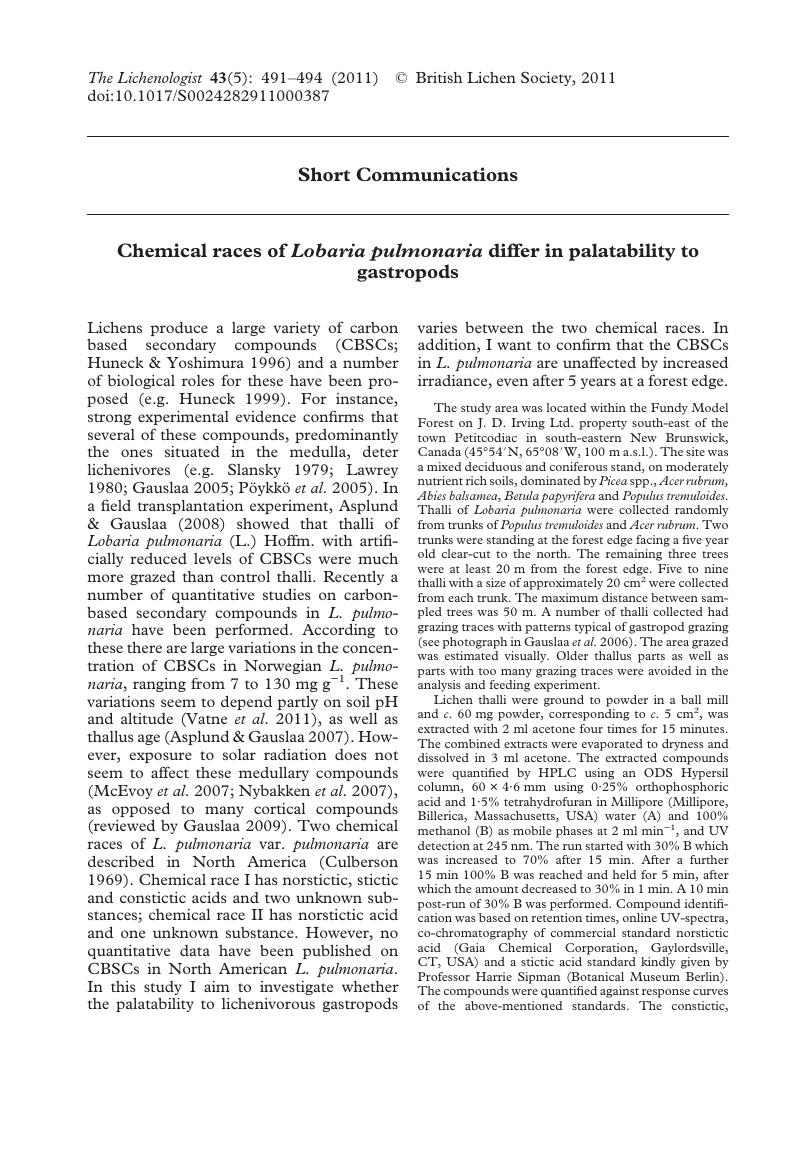Crossref Citations
This article has been cited by the following publications. This list is generated based on data provided by Crossref.
Asplund, Johan
and
Wardle, David A.
2012.
Contrasting changes in palatability following senescence of the lichenized fungi Lobaria pulmonaria and L. scrobiculata.
Fungal Ecology,
Vol. 5,
Issue. 6,
p.
710.
Hodkinson, Brendan P.
and
Hodkinson, Sarah Z.
2012.
Recent literature on lichens—224.
The Bryologist,
Vol. 115,
Issue. 1,
p.
183.
CORNEJO, Carolina
and
SCHEIDEGGER, Christoph
2013.
Morphological aspects associated with repair and regeneration in Lobaria pulmonaria and L. amplissima (Peltigerales, Ascomycota).
The Lichenologist,
Vol. 45,
Issue. 2,
p.
285.
Nadyeina, Olga
Dymytrova, Lyudmyla
Naumovych, Anna
Postoyalkin, Sergyi
Werth, Silke
Cheenacharoen, Saran
and
Scheidegger, Christoph
2014.
Microclimatic differentiation of gene pools in the Lobaria pulmonaria symbiosis in a primeval forest landscape.
Molecular Ecology,
Vol. 23,
Issue. 21,
p.
5164.
Rikkinen, Jouko
2015.
Cyanolichens.
Biodiversity and Conservation,
Vol. 24,
Issue. 4,
p.
973.
Gauslaa, Yngvar
Yemets, Olena A.
Asplund, Johan
and
Solhaug, Knut Asbjørn
2016.
Carbon based secondary compounds do not provide protection against heavy metal road pollutants in epiphytic macrolichens.
Science of The Total Environment,
Vol. 541,
Issue. ,
p.
795.
Gauslaa, Yngvar
Alam, Md. Azharul
Lucas, Pierre-Louis
Chowdhury, Dipa Paul
and
Solhaug, Knut Asbjørn
2017.
Fungal tissue per se is stronger as a UV-B screen than secondary fungal extrolites in Lobaria pulmonaria.
Fungal Ecology,
Vol. 26,
Issue. ,
p.
109.
Asplund, Johan
and
Wardle, David A.
2017.
How lichens impact on terrestrial community and ecosystem properties.
Biological Reviews,
Vol. 92,
Issue. 3,
p.
1720.
Asplund, Johan
Strandin, Ola V.
and
Gauslaa, Yngvar
2018.
Gastropod grazing of epiphytic lichen-dominated communities depends on tree species.
Basic and Applied Ecology,
Vol. 32,
Issue. ,
p.
96.
Gadea, Alice
Charrier, Maryvonne
Fanuel, Mathieu
Clerc, Philippe
Daugan, Corentin
Sauvager, Aurélie
Rogniaux, Hélène
Boustie, Joël
Le Lamer, Anne-Cécile
and
Lohézic - Le Devehat, Françoise
2019.
Overcoming deterrent metabolites by gaining essential nutrients: A lichen/snail case study.
Phytochemistry,
Vol. 164,
Issue. ,
p.
86.
Gadea, Alice
Fanuel, Mathieu
Le Lamer, Anne-Cécile
Boustie, Joël
Rogniaux, Hélène
Charrier, Maryvonne
and
Lohézic-Le Devehat, Françoise
2020.
Mass Spectrometry Imaging of Specialized Metabolites for Predicting Lichen Fitness and Snail Foraging.
Plants,
Vol. 9,
Issue. 1,
p.
70.
Adi Wicaksono, Wisnu
Braun, Maria
Bernhardt, Jörg
Riedel, Katharina
Cernava, Tomislav
and
Berg, Gabriele
2022.
Trade-off for survival: Microbiome response to chemical exposure combines activation of intrinsic resistances and adapted metabolic activity.
Environment International,
Vol. 168,
Issue. ,
p.
107474.
Lõhmus, Asko
Motiejūnaitė, Jurga
and
Lõhmus, Piret
2023.
Regionally Varying Habitat Relationships in Lichens: The Concept and Evidence with an Emphasis on North-Temperate Ecosystems.
Journal of Fungi,
Vol. 9,
Issue. 3,
p.
341.
Ravera, Sonia
Benesperi, Renato
Bianchi, Elisabetta
Brunialti, Giorgio
Di Nuzzo, Luca
Frati, Luisa
Giordani, Paolo
Isocrono, Deborah
Nascimbene, Juri
Vallese, Chiara
and
Paoli, Luca
2023.
Lobaria pulmonaria (L.) Hoffm.: The Multifaceted Suitability of the Lung Lichen to Monitor Forest Ecosystems.
Forests,
Vol. 14,
Issue. 10,
p.
2113.





